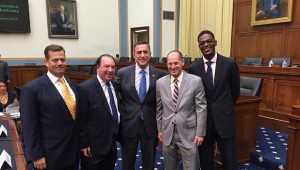 A Congressional hearing on the Internet of Things was held on July 29, 2015.
A Congressional hearing on the Internet of Things was held on July 29, 2015.
“As we talk about your home, your lighting, your messaging, your voice, and, of course, your health and your actual biological function, issues like privacy and data security for these interoperable technologies become not just something to talk about but an area in which we in Congress play a large and potentially destructive — if we’re not careful — role in the development of these technologies,” cautioned the Honorable Bob Goodlatte, Chairman of the Judiciary Committee, U.S. House of Representatives.
Pictured with Chairman Goodlatte are the other witnesses particpating in the hearing: Gary Shapiro, President and CEO of the Consumer Electronics Association; Dean Garfield, President and CEO of the Information Technology Industry Council; Mitch Bainwol, President and CEO of the Alliance of Automobile Manufacturers; and Morgan Reed, Executive Director of ACT |The App Association.
 The illustration from Beecham Research details how the Internet of Things (IoT) is about many, many “things.” Health Populi readers may choose to focus on the Healthcare & Life Science segment, but in fact most of the other segments blur into the larger ecosystem of health — where we live, work, play, and learn in the holistic sense of health and wellbeing.
The illustration from Beecham Research details how the Internet of Things (IoT) is about many, many “things.” Health Populi readers may choose to focus on the Healthcare & Life Science segment, but in fact most of the other segments blur into the larger ecosystem of health — where we live, work, play, and learn in the holistic sense of health and wellbeing.
A key issue wrestled with during the hearing was security — just how to regulate, how much to regulate, and ‘where’ regulation should occur in the IoT communications value chain. The witnesses uniformly opposed the concept of mandatory backdoors in the encryption used in the Internet of Things.
This approach is advocated by law enforcement – specifically, the FBI and NSA. But opponents to this approach argue that such backdoors would be hackable by cyberterrorists, both domestic and those outside of the U.S. Furthermore, inserting this kind of vulnerability, the counter-argument goes, could undermine Americans’ confidence in IoT/connected devices and stall innovation in the marketplace. This, then, could lead to competitive disadvantage for U.S. companies playing in the global IoT market which, in the words of Rep. Goodlatte, is the foundation for “our communication in the 21st century.”
Health Populi’s Hot Points: Cybersecurity and hacking stories are filtering into mass media outlets well beyond technology trade publications. Privacy and security of personal information, including and beyond health data, is front-of-mind for U.S. consumers who are already cautious in the early era of adopting smart/connected home technologies. A ThroughTek survey recently found that cybersecurity is the top concern of the connected home, cited by 25% of respondents in that poll. That statistic is greater for older Americans over 55 years of age (32%) versus people aged 18-34 (22%).
A report from the Acquity Group (part of Accenture Interactive) found a similar proportion of consumers concerned about privacy as a barrier to adopting IoT products, published in 2014’s report, The Internet of Things; The Future of Consumer Adoption.
On August 3 2015, The Washington Post published a story titled Connected medical devices: The Internet-of-things-that-could-kill-you. The FDA issued guidance online on July 31 that a pump used to deliver medicine to patients, the Symbiq Infusion System (manufactured by Hospira) could be hacked by someone who can access a hospital’s computer network. Billy Rios, who had worked as a software engineer with Google, found the security gap in the Hospira pump and saidm “There’s no question that these vulnerabilities ca be used to kill someone.” Hospira subsequently suspending production of the device and pulled it from the market, WashPo reported.
Another aspect which is top-of-mind for me in my consulting work these days, I must ask: “what’s wrong with this picture?” (that is, the photograph).
I’m speaking on Wednesday 5th August in Nashville to one of the largest U.S.-based global technology companies on the question: how will the IoT impact women? Look again at the photograph: there were no female witnesses in the Congressional IoT hearing last week. Yet, as I will discuss tomorrow in my talk, women are the Chief Household and Health Officers of their families, intimately involved in managing their homes. As those homes get (potentially) more connected, women’s voices must be central to designing an IoT ecosystem that resonates with us. As women determine a great percentage of household spending, avoid her voice at your peril, Congress and industry alike.
Cosmopolitan online published a story titled The internet is following you and here is proof, dated July 29 2015. The first sentence reads, “We’re not sure if this feature is cool or creepy.”
Consumers, and especially women, have their “Venus” lens on privacy and data security that will be nuanced differently than men’s “Mars” view. The “creepy” factor mustn’t be overlooked.




 Thank you, Trey Rawles of @Optum, for including me on
Thank you, Trey Rawles of @Optum, for including me on  I was invited to be a Judge for the upcoming
I was invited to be a Judge for the upcoming  For the past 15 years,
For the past 15 years,